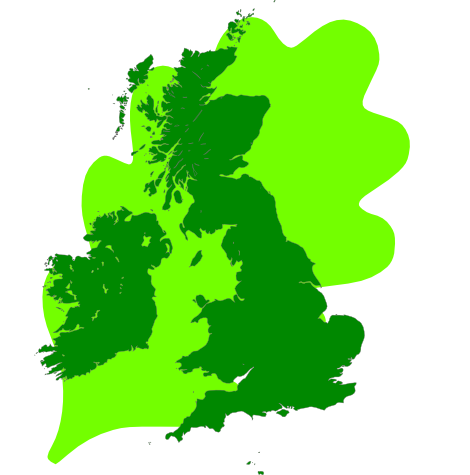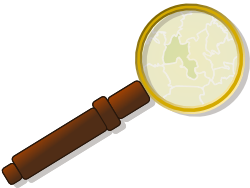Search the Gazetteer
Are the results not as expected? Modify your search term or change the scope to refine your search.
East Wykeham, Lincolnshire (Deserted Village)
East Wykeham is a deserted mediæval village near Ludford in Lincolnshire, in the Parts of Lindsey. The village was depopulated by the late 16th century, the church being in ruins by 1604. Wykeham Hall survived the abandonment of the village, the village earthworks lying in Wykeham Park. The site is within the council area of East Lindsey (Lincolnshire).
Historic England Scheduled Monument 1434272.
Place Type: Deserted Village
Historic County : Lincolnshire
Division: Parts of Lindsey
Lat, Long: 53.376995,-0.159654
Grid Reference: TF225882
Police Area: Lincolnshire
Council Area: East Lindsey (Lincolnshire)
Civil Parish: Ludford CP
Country: England
GBPNID: 301663
Entry Type: Main listing (P)
URL: https://gazetteer.org.uk/place/East_Wykeham,_Lincolnshire_301663
 Peruse Lincolnshire on Wikishire
Peruse Lincolnshire on Wikishire
View on full map
Historic England Scheduled Monument 1434272.
Place Type: Deserted Village
Historic County : Lincolnshire
Division: Parts of Lindsey
Lat, Long: 53.376995,-0.159654
Grid Reference: TF225882
Police Area: Lincolnshire
Council Area: East Lindsey (Lincolnshire)
Civil Parish: Ludford CP
Country: England
GBPNID: 301663
Entry Type: Main listing (P)
URL: https://gazetteer.org.uk/place/East_Wykeham,_Lincolnshire_301663
 Peruse Lincolnshire on Wikishire
Peruse Lincolnshire on WikishireView on full map
Holtham, Lincolnshire (Deserted Village)
Holtham is a deserted mediæval village between North Killingholme and South Killingholme in Lincolnshire, in the Parts of Lindsey. It is within the council area of North Lincolnshire.
Place Type: Deserted Village
Historic County : Lincolnshire
Division: Parts of Lindsey
Lat, Long: 53.634746,-0.265611
Grid Reference: TA147167
Police Area: Humberside
Council Area: North Lincolnshire
Civil Parish: Messingham CP
Country: England
GBPNID: 319165
Entry Type: Main listing (P)
URL: https://gazetteer.org.uk/place/Holtham,_Lincolnshire_319165
 Peruse Lincolnshire on Wikishire
Peruse Lincolnshire on Wikishire
View on full map
Place Type: Deserted Village
Historic County : Lincolnshire
Division: Parts of Lindsey
Lat, Long: 53.634746,-0.265611
Grid Reference: TA147167
Police Area: Humberside
Council Area: North Lincolnshire
Civil Parish: Messingham CP
Country: England
GBPNID: 319165
Entry Type: Main listing (P)
URL: https://gazetteer.org.uk/place/Holtham,_Lincolnshire_319165
 Peruse Lincolnshire on Wikishire
Peruse Lincolnshire on WikishireView on full map
Newsham, Durham (Deserted Village)
Newsham is a hamlet and a deserted mediæval village on the banks of the River Tees in County Durham. Newsham (Anglo-Saxon meaning 'the new dwelling') takes its place name from a settlement around about the 12th century, evidence of which can be seen today along the top of the river Tees bank overlooking the village of Worsall in Yorkshire. Lines of walls, house foundations and other earthworks can still be traced, also the chapel of St James which was sequestered by the Bishop Langley in 1414 for non-payment of rent. This village ceased to exist by 1600. It is within the council area of Stockton-on-Tees.
Historic England Scheduled Monument 1006764.
Place Type: Deserted Village
Historic County : Durham
Lat, Long: 54.493469,-1.4100952
Grid Reference: NZ383110
Police Area: Cleveland
Council Area: Stockton-on-Tees
Civil Parish: Newsham CP
Country: England
GBPNID: 303518
Entry Type: Main listing (P)
URL: https://gazetteer.org.uk/place/Newsham,_Durham_303518
 Peruse Durham on Wikishire
Peruse Durham on Wikishire
View on full map
Historic England Scheduled Monument 1006764.
Place Type: Deserted Village
Historic County : Durham
Lat, Long: 54.493469,-1.4100952
Grid Reference: NZ383110
Police Area: Cleveland
Council Area: Stockton-on-Tees
Civil Parish: Newsham CP
Country: England
GBPNID: 303518
Entry Type: Main listing (P)
URL: https://gazetteer.org.uk/place/Newsham,_Durham_303518
 Peruse Durham on Wikishire
Peruse Durham on WikishireView on full map
Old Newnham, Devon (Mediæval House)
Old Newnham is a historic house near Plympton, Devon. It is within the council area of South Hams (Devon).
Historic England Grade I Listed 1162879.
Place Type: Mediæval House
Historic County : Devon
Lat, Long: 50.397978,-4.0385264
Grid Reference: SX552573
Police Area: Devon & Cornwall
Council Area: South Hams (Devon)
Civil Parish: Sparkwell CP
Country: England
GBPNID: 303632
Entry Type: Main listing (P)
URL: https://gazetteer.org.uk/place/Old_Newnham,_Devon_303632
 Peruse Devon on Wikishire
Peruse Devon on Wikishire
View on full map
Historic England Grade I Listed 1162879.
Place Type: Mediæval House
Historic County : Devon
Lat, Long: 50.397978,-4.0385264
Grid Reference: SX552573
Police Area: Devon & Cornwall
Council Area: South Hams (Devon)
Civil Parish: Sparkwell CP
Country: England
GBPNID: 303632
Entry Type: Main listing (P)
URL: https://gazetteer.org.uk/place/Old_Newnham,_Devon_303632
 Peruse Devon on Wikishire
Peruse Devon on WikishireView on full map
Sydenham, Devon (Jacobean House)
Sydenham is a historic house near Marystow, Devon. It is within the council area of West Devon (Devon).
Historic England Grade I Listed 1164731.
Place Type: Jacobean House
Historic County : Devon
Lat, Long: 50.633249,-4.2245111
Grid Reference: SX427838
Police Area: Devon & Cornwall
Council Area: West Devon (Devon)
Civil Parish: Marystow CP
Country: England
GBPNID: 304813
Entry Type: Main listing (P)
URL: https://gazetteer.org.uk/place/Sydenham,_Devon_304813
 Peruse Devon on Wikishire
Peruse Devon on Wikishire
View on full map
Historic England Grade I Listed 1164731.
Place Type: Jacobean House
Historic County : Devon
Lat, Long: 50.633249,-4.2245111
Grid Reference: SX427838
Police Area: Devon & Cornwall
Council Area: West Devon (Devon)
Civil Parish: Marystow CP
Country: England
GBPNID: 304813
Entry Type: Main listing (P)
URL: https://gazetteer.org.uk/place/Sydenham,_Devon_304813
 Peruse Devon on Wikishire
Peruse Devon on WikishireView on full map
Upham, Wiltshire (Deserted Village)
Upham is a deserted mediæval village near Aldbourne, Wiltshire. A hollow way approximately 650ft in length marks the main thoroughfare through the settlement. The sides of the hollow way are lined by a series of small enclosures, low platforms and short lengths of trackway which mark the location of buildings. The first documentary reference to the settlement is contained in an Anglo-Saxon charter of AD 955 which names it as Upammere. By 1476 Upper Upham was described as `at farm', suggesting that it had been largely depopulated by this point. In 1599 Richard Goddard built Upper Upham House to the south-east of the hollow way. This appears to have radically changed the layout of the settlement and led finally to the abandonment of the hollow way as a thoroughfare. The site is within the council area of Wiltshire.
Historic England Scheduled Monument 1020131.
Place Type: Deserted Village
Historic County : Wiltshire
Lat, Long: 51.496156,-1.676393
Grid Reference: SU225775
Police Area: Wiltshire
Council Area: Wiltshire
Civil Parish: Aldbourne CP
Country: England
GBPNID: 305304
Entry Type: Main listing (P)
URL: https://gazetteer.org.uk/place/Upham,_Wiltshire_305304
 Peruse Wiltshire on Wikishire
Peruse Wiltshire on Wikishire
View on full map
Historic England Scheduled Monument 1020131.
Place Type: Deserted Village
Historic County : Wiltshire
Lat, Long: 51.496156,-1.676393
Grid Reference: SU225775
Police Area: Wiltshire
Council Area: Wiltshire
Civil Parish: Aldbourne CP
Country: England
GBPNID: 305304
Entry Type: Main listing (P)
URL: https://gazetteer.org.uk/place/Upham,_Wiltshire_305304
 Peruse Wiltshire on Wikishire
Peruse Wiltshire on WikishireView on full map
West Wykeham, Lincolnshire (Deserted Village)
West Wykeham is a deserted mediæval village near Ludford in Lincolnshire, in the Parts of Lindsey. The village was depopulated by the end of the 14th century. A combination of earthworks and cropmarks clearly depict the street pattern, the site of the church, building platforms and associated enclosures. The site is within the council area of East Lindsey (Lincolnshire).
Historic England Scheduled Monument 1004989.
Place Type: Deserted Village
Historic County : Lincolnshire
Division: Parts of Lindsey
Lat, Long: 53.379503,-0.171904
Grid Reference: TF217885
Police Area: Lincolnshire
Council Area: East Lindsey (Lincolnshire)
Civil Parish: Ludford CP
Country: England
GBPNID: 305487
Entry Type: Main listing (P)
URL: https://gazetteer.org.uk/place/West_Wykeham,_Lincolnshire_305487
 Peruse Lincolnshire on Wikishire
Peruse Lincolnshire on Wikishire
View on full map
Historic England Scheduled Monument 1004989.
Place Type: Deserted Village
Historic County : Lincolnshire
Division: Parts of Lindsey
Lat, Long: 53.379503,-0.171904
Grid Reference: TF217885
Police Area: Lincolnshire
Council Area: East Lindsey (Lincolnshire)
Civil Parish: Ludford CP
Country: England
GBPNID: 305487
Entry Type: Main listing (P)
URL: https://gazetteer.org.uk/place/West_Wykeham,_Lincolnshire_305487
 Peruse Lincolnshire on Wikishire
Peruse Lincolnshire on WikishireView on full map
« First ‹ Prev ( Page 1 of 1 ) Next › Last »


 Menu
Menu